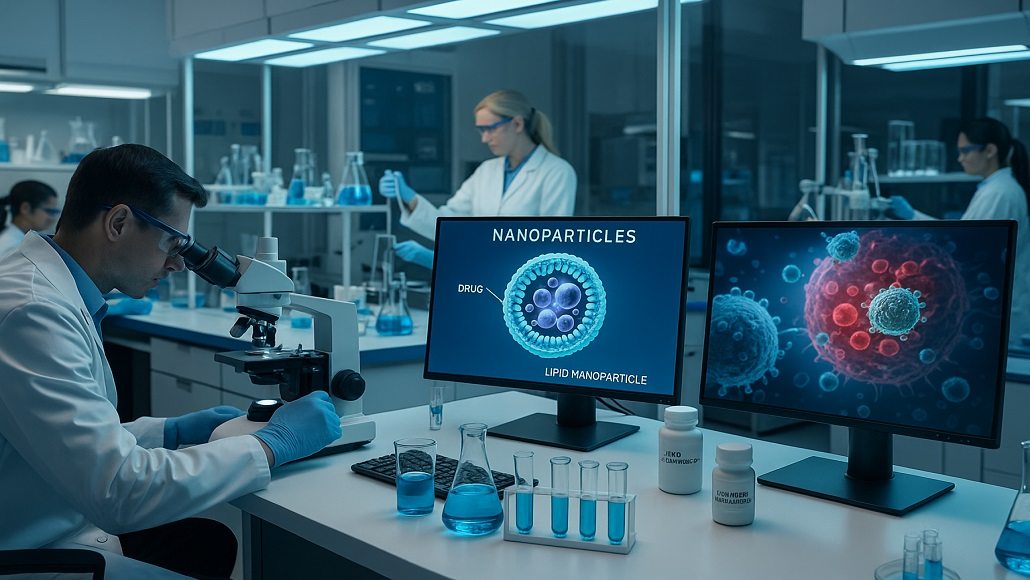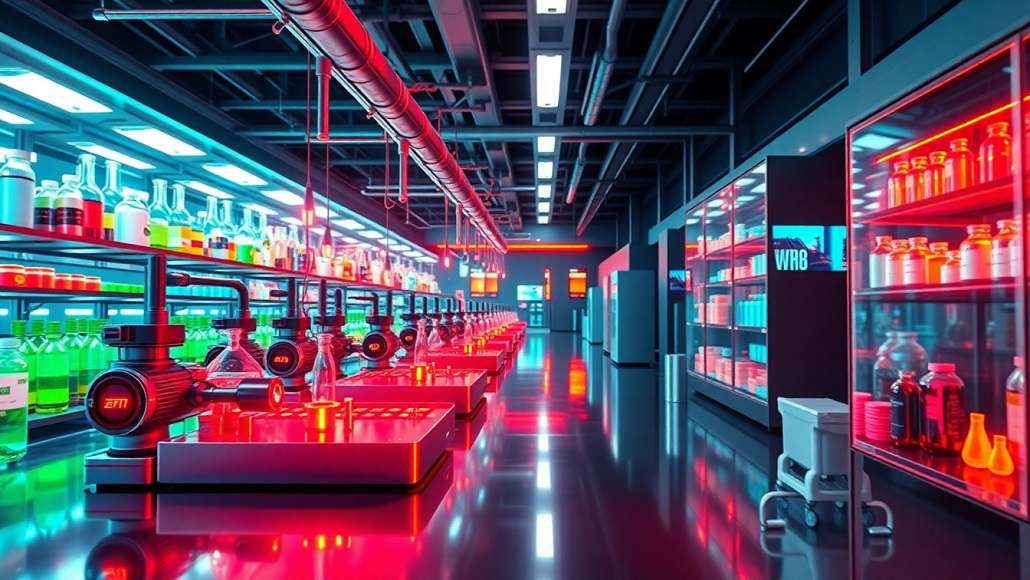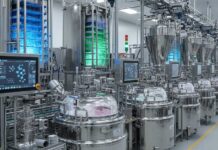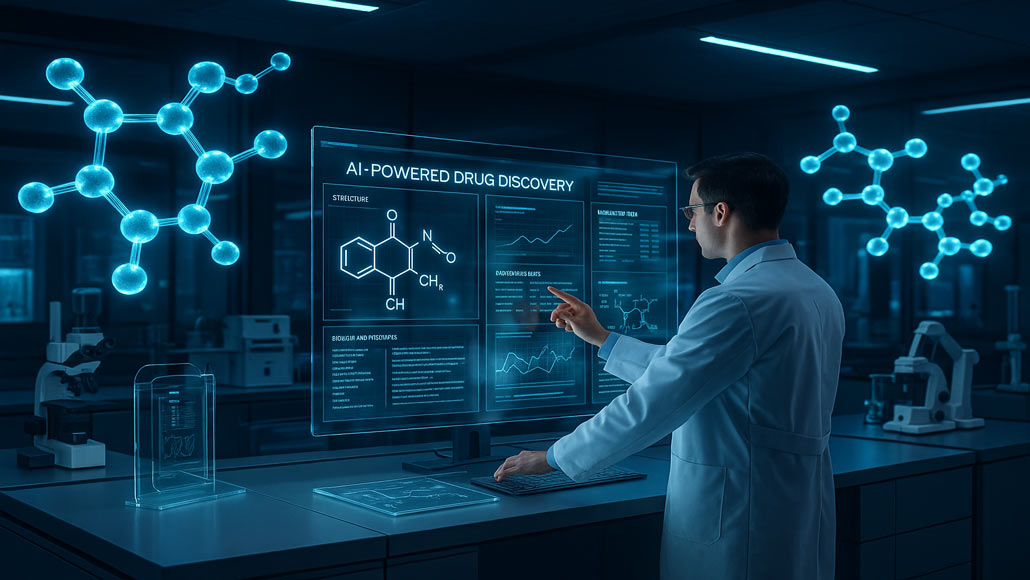Generative AI for Drug Discovery: Accelerating Molecule Design in the Lab
The landscape of pharmaceutical research is undergoing a revolutionary transformation as generative artificial intelligence emerges as a game-changing technology in drug discovery. Traditional molecule design processes, which historically required decades of painstaking research and billions of dollars in investment, are being dramatically accelerated through sophisticated AI algorithms that can design, predict, and optimize molecular structures with unprecedented speed and accuracy. This paradigm shift represents one of the most significant advances in pharmaceutical science, offering the potential to address unmet medical needs more rapidly than ever before.
The Traditional Challenges of Molecule Design
Conventional drug discovery approaches face numerous limitations that have contributed to the industry’s notorious reputation for lengthy development timelines and high failure rates. The process of identifying promising molecular candidates typically involves screening millions of compounds through expensive and time-consuming laboratory experiments, with success rates often falling below ten percent for compounds that ultimately receive regulatory approval.
Chemical space exploration represents a particularly daunting challenge, as the theoretical number of drug-like molecules exceeds 10^60 compounds—a number so vast that traditional screening approaches can only sample a minuscule fraction of potential therapeutic candidates. Researchers must navigate complex structure-activity relationships, predict molecular properties across multiple biological systems, and account for factors including efficacy, safety, pharmacokinetics, and manufacturability.
The iterative nature of traditional molecule optimization further compounds these challenges. Each design cycle requires synthesis, testing, analysis, and redesign phases that can consume months or years, particularly when researchers encounter unexpected biological responses or encounter synthetic chemistry obstacles. These limitations have historically created significant barriers to addressing rare diseases, antimicrobial resistance, and other urgent medical needs that require rapid therapeutic development.
AI drug discovery methodologies address these fundamental limitations by leveraging computational approaches that can explore vast chemical spaces, predict molecular properties, and optimize compound structures without requiring extensive laboratory synthesis and testing phases.
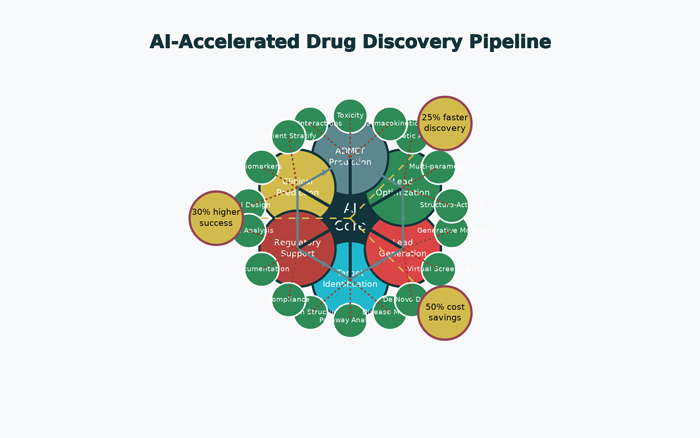
Generative AI Approaches to Molecular Design
Modern generative AI systems employ sophisticated algorithms including Generative Adversarial Networks, Variational Autoencoders, and transformer-based architectures to create novel molecular structures with desired properties. These systems learn from extensive databases of known compounds, biological activities, and structure-property relationships to generate entirely new molecules that possess specific therapeutic characteristics.
The training process involves exposing AI models to millions of molecular structures along with their associated biological and chemical properties. Through this comprehensive learning process, the algorithms develop an understanding of the fundamental relationships between molecular structure and biological activity, enabling them to propose novel compounds that are likely to exhibit desired therapeutic effects.
Generative models can produce molecular candidates optimized for multiple objectives simultaneously, including target binding affinity, selectivity, metabolic stability, and safety profiles. This multi-objective optimization capability represents a significant advancement over traditional approaches that typically optimize single properties in isolation, often leading to suboptimal overall compound profiles.
The technology enables researchers to specify desired molecular properties as input parameters, allowing the AI system to generate compounds tailored to specific therapeutic requirements. For instance, researchers can request molecules with high blood-brain barrier penetration for neurological disorders, or compounds with extended half-lives for chronic disease management.
Accelerating Lead Identification and Optimization
The lead identification phase, traditionally one of the most resource-intensive aspects of drug discovery, becomes dramatically more efficient when powered by generative AI algorithms. These systems can screen virtual libraries containing millions of computationally generated compounds in matters of hours, identifying promising candidates that would require years to discover through conventional screening approaches.
AI drug discovery platforms can rapidly evaluate molecular candidates against multiple therapeutic targets simultaneously, identifying compounds with Poly pharmacological profiles that may offer superior therapeutic efficacy compared to single-target approaches. This capability is particularly valuable for complex diseases including cancer, neurodegeneration, and metabolic disorders that involve multiple biological pathways.
Lead optimization processes benefit significantly from AI-guided molecular modification strategies that can predict the impact of structural changes on biological activity, pharmacokinetic properties, and safety profiles. Researchers can explore hundreds of molecular variations computationally before selecting the most promising candidates for laboratory synthesis and testing.
The technology enables iterative optimization cycles where experimental results are fed back into AI models to refine predictions and guide subsequent design efforts. This closed-loop approach ensures that AI systems continuously improve their predictive capabilities while generating increasingly optimized molecular candidates.
Advanced AI algorithms can also predict synthetic accessibility, identifying molecular designs that can be efficiently manufactured using established chemical processes. This practical consideration significantly reduces development timelines by ensuring that promising compounds can be readily synthesized for further evaluation.
Integration with High-Throughput Experimental Validation
Modern pharmaceutical laboratories are integrating generative AI systems with automated high-throughput screening platforms to create seamless pipelines that combine computational design with experimental validation. These integrated systems can design compounds, predict their properties, synthesize promising candidates using automated chemistry platforms, and evaluate their biological activities using robotic screening systems.
The integration process involves sophisticated data management systems that can capture experimental results, analyze structure-activity relationships, and provide feedback to AI design algorithms. This real-time learning capability enables continuous improvement of molecular design strategies based on actual experimental outcomes rather than relying solely on computational predictions.
Automated synthesis platforms guided by AI recommendations can produce diverse molecular libraries tailored to specific research objectives. These systems can explore chemical modifications that might not be immediately obvious to human chemists, leading to the discovery of novel structure-activity relationships and breakthrough therapeutic candidates.
Quality control processes enhanced by AI analysis ensure that synthesized compounds meet purity and structural requirements before proceeding to biological evaluation. This automated quality assessment reduces the risk of false negative results due to compound degradation or synthetic impurities.
Addressing Complex Therapeutic Targets
Generative AI excels at designing molecules for challenging therapeutic targets that have proven difficult to address using traditional drug discovery approaches. These “undruggable” targets, which include protein-protein interactions, intrinsically disordered proteins, and allosteric binding sites, require innovative molecular designs that may not be apparent through conventional structure-based drug design methods.
The technology can generate macrocyclic compounds, peptide-drug conjugates, and other complex molecular architectures that offer unique opportunities for engaging difficult targets. AI algorithms can optimize these sophisticated molecular designs for stability, permeability, and other drug-like properties while maintaining target binding affinity.
Allosteric modulator design represents a particularly promising application area, as AI systems can identify binding pockets distant from active sites and design molecules that modulate protein function through conformational changes. This approach offers advantages including improved selectivity and reduced likelihood of resistance development.
The ability to design molecules that simultaneously engage multiple targets enables the development of network-based therapeutic approaches that may be more effective for complex diseases. AI systems can optimize these multi-target compounds to achieve balanced activity profiles across different therapeutic targets.
Predicting and Optimizing ADMET Properties
Absorption, Distribution, Metabolism, Excretion, and Toxicity (ADMET) properties represent critical determinants of drug success that can be effectively predicted and optimized using generative AI approaches. Traditional ADMET optimization often occurs late in development programs, leading to costly failures when promising compounds exhibit poor pharmacokinetic or safety profiles.
AI-driven ADMET prediction enables early-stage optimization of molecular properties that influence drug performance in biological systems. These predictive models can assess blood-brain barrier penetration, hepatic clearance, cardiac toxicity risk, and numerous other factors that determine clinical success.
The technology enables simultaneous optimization of efficacy and ADMET properties, generating molecular candidates that achieve optimal balance across multiple performance criteria. This integrated approach significantly reduces the likelihood of late-stage development failures due to pharmacokinetic or safety issues.
Machine learning models trained on extensive databases of clinical compounds can predict human pharmacokinetic parameters with increasing accuracy, enabling better estimation of optimal dosing regimens during early development phases. This predictive capability supports more efficient clinical trial design and regulatory submission strategies.
Enabling Personalized Medicine Approaches
Generative AI facilitates the development of personalized therapeutic approaches by designing molecules optimized for specific patient populations or genetic variants. These systems can analyze genomic data, protein expression profiles, and clinical characteristics to generate molecular candidates tailored to individual patient needs.
The technology enables rapid design of companion diagnostics that can identify patients most likely to benefit from specific treatments. This precision medicine approach improves therapeutic outcomes while reducing the risk of adverse events in patient populations unlikely to respond to particular treatments.
AI-driven molecular design can account for genetic variations that influence drug metabolism, target expression, or disease progression patterns. This capability enables the development of therapeutic strategies that address inter-patient variability more effectively than traditional one-size-fits-all approaches.
Population-specific drug design becomes feasible through AI analysis of diverse datasets that capture genetic, environmental, and clinical factors influencing therapeutic response. This approach supports global health initiatives by enabling the development of treatments optimized for different population groups.
Regulatory and Validation Considerations
The integration of generative AI into drug discovery workflows requires careful attention to regulatory requirements and validation strategies that ensure AI-generated molecular candidates meet safety and efficacy standards. Regulatory agencies are developing frameworks for evaluating AI-driven drug discovery processes, emphasizing the importance of transparent methodologies and robust validation approaches.
Validation strategies must demonstrate that AI-generated predictions correlate with experimental outcomes across diverse molecular classes and therapeutic areas. This requires comprehensive benchmarking studies that evaluate AI performance against historical compound databases and prospective experimental validation campaigns.
Documentation requirements for AI-driven discovery processes must capture algorithm details, training data characteristics, prediction confidence levels, and validation methodologies. This comprehensive documentation supports regulatory review processes and enables reproducibility across different research environments.
Quality assurance protocols must ensure that AI systems maintain consistent performance over time and across different molecular design challenges. Regular model updates, performance monitoring, and validation testing ensure that AI recommendations remain reliable and scientifically sound.
Future Directions and Emerging Technologies
The future of AI-driven drug discovery involves increasingly sophisticated algorithms that can design molecules with complex properties including tissue-specific targeting, controlled release characteristics, and multi-modal therapeutic mechanisms. These advanced capabilities will enable the development of next-generation therapeutics that address current limitations of conventional drug design approaches.
Integration with quantum computing technologies promises to enhance molecular property prediction capabilities by enabling more accurate simulation of quantum mechanical effects that influence drug-target interactions. This technological convergence may unlock new approaches to molecular design that are currently computationally intractable.
Collaborative AI systems that combine multiple algorithmic approaches offer the potential to generate molecular candidates that benefit from diverse computational strategies. These ensemble methods may achieve superior performance compared to individual algorithms by leveraging complementary strengths across different design challenges.
Real-world evidence integration will enable AI systems to learn from clinical outcomes, post-market surveillance data, and patient registries to continuously improve molecular design strategies. This feedback mechanism will ensure that AI-generated compounds are optimized for real-world therapeutic performance rather than solely laboratory-based metrics.
Conclusion
Generative AI represents a transformative technology that is fundamentally changing how pharmaceutical companies approach molecular design and drug discovery. The ability to rapidly generate, evaluate, and optimize molecular candidates offers unprecedented opportunities to address unmet medical needs while reducing development timelines and costs.
AI drug discovery methodologies are enabling pharmaceutical companies to explore vast chemical spaces, design molecules with complex property profiles, and optimize therapeutic candidates more efficiently than traditional approaches. This technological revolution promises to accelerate the development of life-saving therapeutics while making drug discovery more accessible to organizations focused on rare diseases and neglected therapeutic areas.
The successful integration of generative AI into pharmaceutical research requires careful attention to validation, regulatory compliance, and quality assurance considerations. Organizations that invest in robust AI implementation strategies while maintaining scientific rigor will be positioned to realize the full potential of this transformative technology in their drug discovery efforts.





